
| The Greek islands | Naxos HOME | Naxos Hotels | Naxos Beaches | Naxos History | Naxos Sights | Naxos Travel |
| Naxos Chora | Naxos Restaurants | Movies of Naxos island | Movies of Naxos Beaches |





|
Google Chrome thinks enlarging my pictures, some links and sometimes scrolling through the pages is a popup. If you want to navigate my website than please allow "popups". |
| The island of Naxos in the Cyclades in Greece - island of large and sandy beaches |
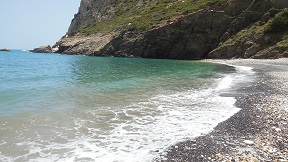 |
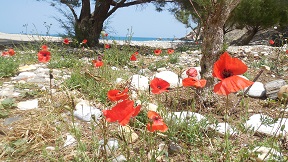 |
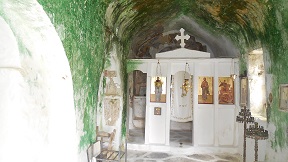 |
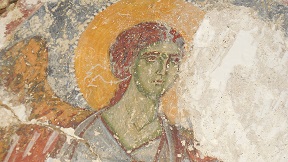 |
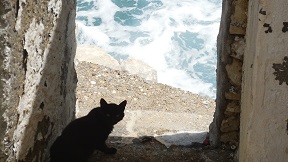 |
 |
 |
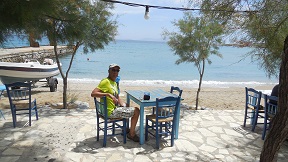 |
 |
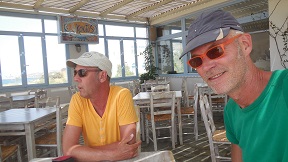 |
|
The main town of Naxos is a bit bigger than most towns on other islands, but it is very attractive. There is a Venetian castle (that is still lived in) at the top of the hill dominating the village, and there are cute narrow streets with tourist shops. At the north side of the village there is an island connected by a path to Naxos Town, and on it there is an ancient gate of an old temple. In and around the harbour you find many shops, restaurants, coffee shops and bars, and there is a long boulevard looking out over the neighbouring island of Paros. We think that the people on the island are very friendly and polite, and that they have a good sense of humour. Naxos is a Greek island with a surface of 448 km², making it the largest island in the Cycladic island group, to which for instance also belong the islands of Tinos, Mykonos and Paros. It is well known since ancient times for its marble and its wine (the poet Archilochus compared it to the divine drink nectar and there was a strongly developed cultus for the god Dionysus. Also the local liquor, Kitron, is a well known delicatesse of the island). The island of Naxos has about 12.000 inhabitants. It is quite mountainous and, especially in comparison to the surrounding islands, reasonably green and fertile. The landscape reminded me the most of other islands like Samos or Crete: quite pretty. A mighty mountain chain, the Zas, towers 1001 meter above the sea level and can be seen from almost everywhere on the island. On the fertile lowland (by irrigation) citrus fruit trees, olives and grapes are grown, while in the mountain sheep and goats are held for the production of cheese. Marble and amaril are still dug out. The island of Naxos has rather large sandy beaches and dunes along the coastline, now making tourism one of the most important pillars of income. |
| How to get to the island of Naxos in Greece by ferry or by plane |
|
|
| Rent a car on the island of Naxos - Naxos car rentals |
|
Compare prices of the different car rentals and different kinds of cars with reviews of the car rental company on the website of rentalcars.com - click here. |
| The capitol of the island of Naxos in Greece - Naxos Town or Naxos Chora |
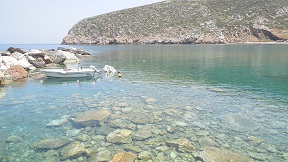 |
 |
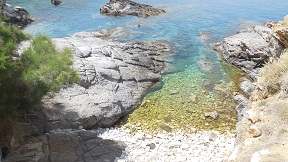 |
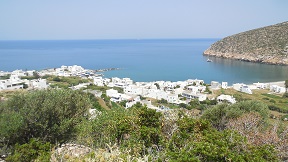 |
 |
 |
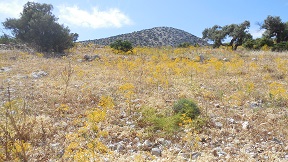 |
 |
 |
 |
|
The official name of the capital is Naxos (-town), but is often referred to (as on other islands) as Chora. It is the home of the Greek orthodox bishop and a Roman Catholic archbishop. Naxos is one of the most popular Greek islands with island hoppers. A large number of people visit it and the average length of stay is also greater than that for other popular Greek island destinations. This is due to the combination of an attractive island port, many beautiful large and easy accessible sandy beaches with sand dunes, and a fertile and green interior with old villages and old ruins. Naxos also has good ferry connections and is often the starting point for people that want to travel to Amorgos or to one or more of the islands of the small Cyclades (Koufonissia, Schinoussa, Iraklia and Donoussa). The opening of the airport on the island also brought quite a few tourists to Naxos. The airport is situated at a mere 1 kilometre distance from the Chora, or five minutes by car. Most of the tourists stay concentrated around Naxos Chora and the direct surroundings though and other parts of the island are much more quiet. Naxos Town or Naxos Chora is the arrival point for the ferry visitors. It has a nice waterfront with terraces, taverna's and shops and behind that there are winding and often steep little streets with small white houses. On top of the Chora is the Venetian castle or Kastro. Most people stay in Naxos Town during their stay or somewhere closeby and than visit the nearby miles of sandy beaches during the daytime. If you want to take a look at the map of Naxos Chora than please click here. |
 |
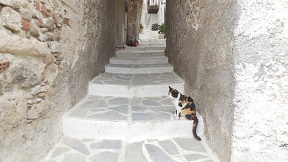 |
 |
 |
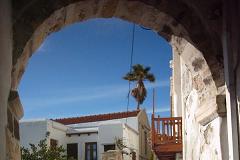 |
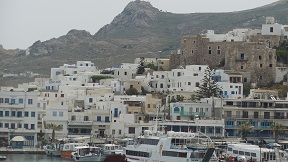 |
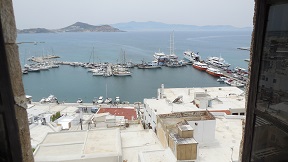 |
 |
 |
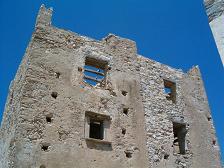 |
|
You can easily spend an entire day strolling through the capital of Naxos Chora and look at the historic buildings. It is also enjoyable to sit in the harbour with a cup of coffee, a drink or with a meal (because the food on this island is excellent where-ever we were). Close to the place where the ferries come in there is a restaurant that is opened 24 hours a day and they serve a good breakfast. The town beach was still pretty busy in September, because there are quite a bit of hotels in Naxos Chora, but actually the whole coastline of Naxos is a beach. Once you get into the streets behind the boulevard and walk through the Chora you will see the old and attractive face of the town. On top of the hill lies the well preserved Venetian castle, that was build on the remains of the old acropolis (you can have a look inside as well, entrance fee 5 euro in 2014). Part of the castle is still inhabited. There is a Roman Catholic cathedral and quite a large and very interesting archaeological museum, with finds from Naxos and surrounding smaller islands (such as objects from Donoussa and Keros island). |
| The beaches and naturist beaches on the island of Naxos in Greece |
 |
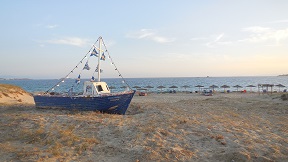 |
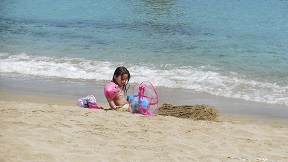 |
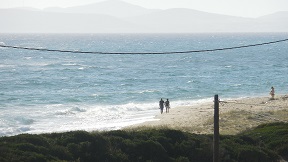 |
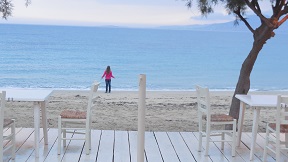 |
 |
 |
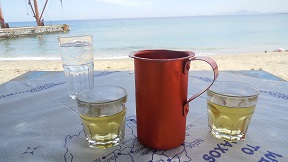 |
 |
 |
|
The whole western coastline of Naxos south of the Chora is one big beach. We have seen it from the ferry a couple of times, and we have seen it from our car when we drove past. You can find a place in the sand all for yourself without sharing it with the lot if you like that, and the beaches belong to the best of the Cyclades, or actually the are counted amongst the best in the whole wide world (they are in the top 10). But also in the east, in the south and in the north of the island there are plenty of nice beaches. Naxos is the biggest of the cycladic islands, so it is worth renting a car for a couple of days and take a good look around the island. The stretch with beaches on the west coast of the island has no equal in the Cyclades. The beaches are miles long, have soft sand and are also broad. Sometimes they have dunes behind it. The nearest beach to Chora is called Agios Georgios, and this is a busy family beach. South of Agios Georgios is the airport of Naxos and to the west the popular beach Stelida with hitstaverna. To the south of these beaches begin the larger sandy beaches as (successively) Agios Prokopias, Agia Anna, Golden beach (a large naturist beach), Maragas, Plaka (a mixed textile and naturist beach), Mikri Vigla, Kastraki, Alyki and Pyrgaki. Further in the south are more the difficult to reach beaches Kalando and Rena (we of course went there - over a long and bumpy dirt track - drove carefully and then after that a long way walk. In the meantime most of the road has been transformed and is easier to drive). North of Chora you find quiet en smaller beaches in coves between the village of Engares and the village of Agia in the north, of which Abram is probably the most picturesque. The former dirttrack between Agia en Apollonas has recently been made into an asfalt road, making it easier to visit this lovely village. The villages of Moutsana and Lionas, situated at the east side of the island of Naxos, are really attractive and both of them have a beach, allthough the beach of Lionas consists of large white pebbles. South of Moutsana there are dozens of coves with small sandy beaches around Kleidos, Psili Amos and (windy) Panermos. For more information about the beaches and naturist beaches on the island of Naxos, go to my special beaches page - click here. |
| The sights of the island of Naxos in Greece |
 |
 |
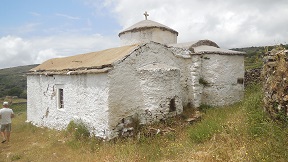 |
 |
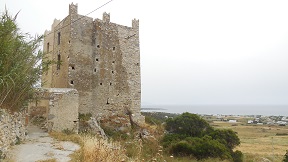 |
 |
 |
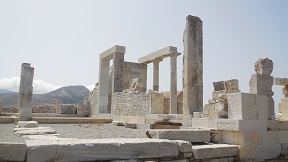 |
 |
 |
|
From the ancient city of Naxos is hardly anything left that can be detected nowadays. Interesting is the 6-meter-high marble Portára port on the island Palatia that dominates the harbour of Naxos Town. It dates from around 525 BC. Built as a temple entrance (of presumably for the god Apollon), it was never completed after the fall of Lygdamis. The medieval town is situated above the harbour and is further divided into the Venetian Kastro, where once the Catholic nobility lived and the Bourgo, where the indigenous Greeks lived. The 18th-century Orthodox cathedral in the Bourgo, Mitrópoli Zoödóchou Pígis (meaning the life giving source), possesses a remarkable iconostas painted by Dimítrios Válvis, a painter from the so-called School of Crete. The Kastro with another twenty imposing mansions can be seen, decorated with the coat of arms of the Venetian nobles who lived there. Members of the family of the Duke Sanudo lie buried in the 13th-century Catholic cathedral in the Kastro. In the palace of the Sanudo (in its present form from 1627) has long been a school and housed the writer Nikos Kazantzakis as the most famous pupil. Now there is the Archaeological Museum with a fine collection of marble sculptures from the Cycladic civilization. The village Apollonas, 48 km from Naxos city on the north coast of the island, is located at the site of an ancient settlement with a shrine for the god Apollon. A staircase leads to the ancient marble place where from about 600 BC the unfinished statue of a kouros has been laying. Only the contours are finished. The 10.5 m long and 30 tonnes heavy image suggests a bearded figure, maybe picturing the god Dionysus (because Apollon is almost never shown with a beard). After a sculptor found a structural mistake in the marble, making it unusable, they stopped working on it and left the statue behind unfinished. A similar and equally large-screen Apollon stood up to the Hall of the the people of Naxos on Delos. The village Apiranthos, 25 km southeast of Naxos City, was founded in the 17th century by Cretans while fleeing the Turks. The attractive village has beautiful, marble paved streets and an apartment built by the Venetian family Crispi. Men still often bear the traditional costume. There is also a small museum with an archaeological and geological department. In the village Melanes, which is located 8 kilometers southeast of Chora, there is another (6.4 meters tall) kouros. This kouros is more detailed. The statue dates from the 7th century BC and in the area there is also a sanctuary and a marble quarry. Near the top of a hill a second kouros statue, but we could not reach it because of the rain which had put part of the route under water. The village of Apiranthos, 25 km south-east of Naxos town, was founded in the 17th century by Cretans fleeing from the Turks. They came to work there in the amaril mines that are located nearby. The attractive village has beautiful marble-paved streets and residential towers built by the Venetian family Crispi. people often still wear the traditional costume. There is also a small museum with an archaeological and geological department. Scattered over the island there are several old Byzantine churches. Often they are located close to pretty little villages and some of them contain some beautiful frescoes. In Sangri, southwest of Chora, just south of Vivlos, there is a medieval castle and a church dating from the 13th century with well-preserved frescoes. On the route from the Venetian Bazeos tower to the Dimitra temple on the left side of the road there is the small Byzantine chapel of Agios Ioannis Theologos. One of the most beautiful and the oldest cathedral on the island is the Agios Mamas church in Potamia. We visited the white-painted Byzantine church in the deserted village Sifones (on the route from Koronas to Moni). Here the door was open, and inside the church were still visible remains of beautiful frescoes. At 1.5 kilometers distance of Sangri is one of the main attractions of the island of Naxos, Dimitra's Temple, which dates back to 530 BC. The marble temple dedicated to the goddess Dimitra, the goddess of agriculture and harvest, is still largely intact (50% of the old building blocks are still on the site). It was built during the reign of the tyrant Lygdamis, who also ordered the construction of the temple in Naxos town, of which now only the gate is still standing. In the 6th century AD, the temple was converted into a church. On the site of the temple is a museum, but it was closed when we were there in May. |
| Naxos hotels: Acti Plaka apartements and studios in Plaka beach |
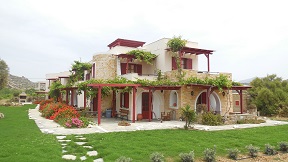 |
 |
 |
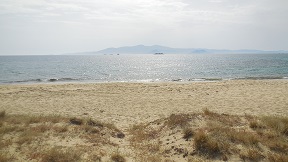 |
 |
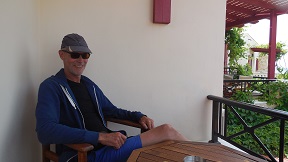 |
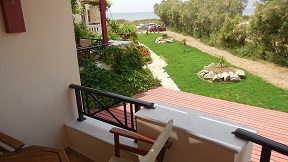 |
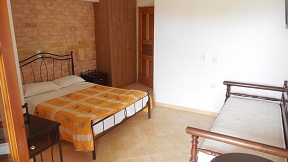 |
 |
 |
|
This is where we spent our week holiday on Naxos island: Acti Plaka, situated right across a wonderful sandy beach where wearing swimming textile is optional. The property lies at the end of a 2,5 kilometer long quiet dirt road (but wide and very well drivable - these roads seem to attract a different kind of people: the ones looking for peace and quiet). We weren't so sure if we were going to like Naxos that much (but we did...). The setting of the building, the lack of a lot of noise and the beach a stones throw away, made our stay really pleasant. There are umbrellas for the guests that you can borrow if you want to spend some time on the beach. Nearby are some really nice tavernas to choose from. The beach is partly umbrellas and sunbeds and partly undeveloped. We loved it so much and there is much to see in Naxos, we stayed for a week. Acti Plaka is a family business mainly run by two sisters. Evi is a real sweetheart, and came to wave goodbye at the airport when we flew back to Athens. They arranged a car for us on arrival on the island (very good price!!). We had two adjoining studios, both very nice and both with a balcony with a sea view. The studios were cleaned every day and there was regular change of towels and bedsheets. And yes there was wifi ;). A nice place if you want to relax and be by the sea.
Tel: +30-22850-42581 Mobile: +30-22850-24800 - Send an e-mail to Acti Plaka Apartments & Studios on Naxos.
|
| Naxos Hotels: Ikaros Studios - Naxos Town |
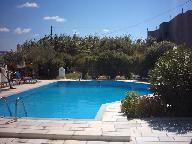 |
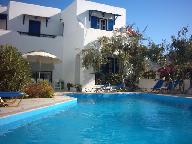 |
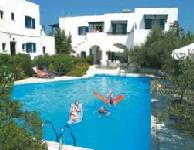 |
 |
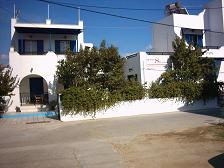 |
|
|
|
|
|
|
|
Ikaros is a family hotel which offers accommodation all year. It is situated in a quiet corner near the city of Naxos (800m) and very close to the saint George beach (300m). Moreover, it is easily accessible from the airport, being only 1,5 km away from it. This unique location enables our guests to combine entertainment along with relaxation. Ikaros has been designed to satisfy the needs of its guests, you can take your coffee with a view of our beautiful garden or take a refreshing swim in our pool. All our studios have a spacious bathroom, telephone, television, radio, fully equipped kitchen, fridge, air-condition, safety box and a big balcony. Ikaro's personnel is always trying to make our guest's stay as comfortable as possible. And I can say this from my own experience: they are very friendly and helpful indeed! The studios are wihin easy walking distance from the village center, and out of the noise of the village itself. Closeby you can also find a bakery that serves a good breakfast and coffee outside on their terrace. Check availabilities and prices & book the Ikaros Studios in Naxos - click here. For more hotels, apartments and studios on the island of Naxos - click here. |
© Hans Huisman, https://www.angelfire.com/super2/greece/ 2018

 Naxos can be easily reached from Piraeus (near Athens) where there are daily connections to the Cyclades. The journey takes about 5 hours but it depends on the speed of the ferry and the route it takes. At the airport of Athens there is a regular connection to Piraeus. It is also possible to fly to Mykonos and travel on from there. In this case the journey takes about 2 to 3 hours by boat.
If you want to check the ferries from and to Naxos and order a ticket -
Naxos can be easily reached from Piraeus (near Athens) where there are daily connections to the Cyclades. The journey takes about 5 hours but it depends on the speed of the ferry and the route it takes. At the airport of Athens there is a regular connection to Piraeus. It is also possible to fly to Mykonos and travel on from there. In this case the journey takes about 2 to 3 hours by boat.
If you want to check the ferries from and to Naxos and order a ticket -  Naxos has an airport for for domestic flights and can also be reached by plane from Athens (national flights only because there is no international airport). For plane tickets from Athens to the island of Naxos check
Naxos has an airport for for domestic flights and can also be reached by plane from Athens (national flights only because there is no international airport). For plane tickets from Athens to the island of Naxos check 